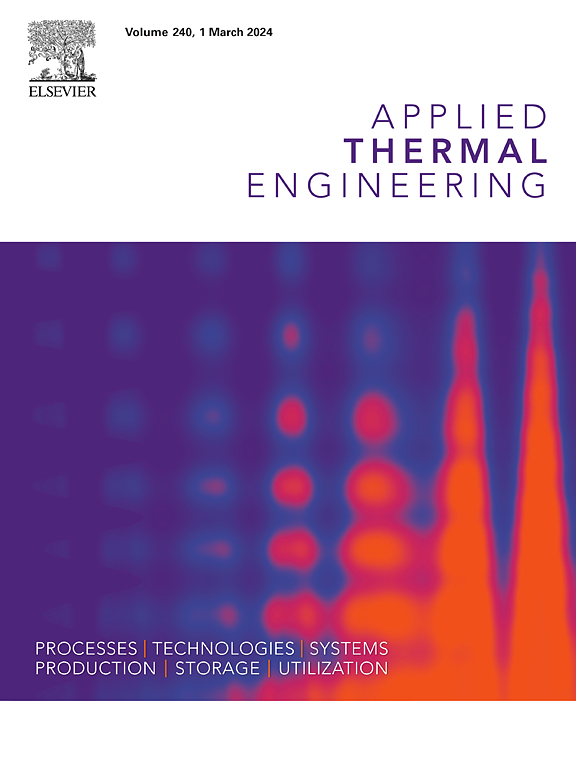Solar still performance enhancement with reflectors and various shapes of absorber plates
IF 6.9
2区 工程技术
Q2 ENERGY & FUELS
引用次数: 0
Abstract
Considering the importance of desalination and the freshwater crisis in the world, as well as the low efficacy of solar still distillation systems, it is important to enhance the productivity of solar desalination systems using proper techniques. In this experimental study, two devices were built and two methods were applied to improve the productivity of solar still systems. The first method is to corrugate the absorber plate to have higher surfaces for evaporation and solar radiation absorption, and the second method is to use reflective mirrors. So far, various methods have been used to enhance the performance of the solar stills, but in this study, for the first time, the simultaneous effect of using upper and lower reflective mirrors and different geometries of the absorber plate on the efficiency enhancement of solar still systems have been investigated. The purpose of this study is to conduct several tests on the solar desalination devices with reflectors and different absorber plates, including a simple absorber plate, a triangular absorber plate. The reflectors are used to increase the solar radiation absorption by the evaporation unit of the solar desalination device. It was found that the production of freshwater is higher by using the triangular absorber plate as compared with square and simple absorber plates. The use of reflectors significantly increases freshwater production during the afternoon hours. The lowest cost of 0.036 $/L/m2 for producing freshwater belongs to the solar still with an external reflector and a triangular absorber plate. The highest daily efficiency of 32.1% was reported for the solar still with a reflector and a triangular absorber plate. Using a reflector in the solar still system enhances the efficiency of freshwater production by 26% compared to a desalination system without a reflector. Using a triangular absorber plate and a square absorber plate in a solar still increases the efficacy of freshwater production by 25.7% and 20%, respectively, compared to a desalination system with a simple absorber plate.
利用反射器和各种形状的吸收板来增强太阳能性能
考虑到海水淡化的重要性和世界淡水危机,以及太阳能蒸馏系统的低效率,利用适当的技术提高太阳能海水淡化系统的生产力是很重要的。在本实验研究中,建立了两个装置,并采用了两种方法来提高太阳能蒸馏系统的生产率。第一种方法是将吸收板做成波纹状,使其具有更高的表面,以便蒸发和吸收太阳辐射,第二种方法是使用反射镜。到目前为止,人们已经采用了各种方法来提高太阳能蒸馏器的性能,但在本研究中,首次研究了同时使用上下反射镜和不同几何形状的吸收板对太阳能蒸馏器系统效率提高的影响。本研究的目的是对具有反射器和不同吸收板的太阳能脱盐装置进行试验,包括简单吸收板、三角形吸收板。反射器用于增加太阳能脱盐装置蒸发单元对太阳辐射的吸收。结果表明,三角形吸收板比正方形和简单吸收板的淡水产量更高。使用反射器大大增加了下午的淡水产量。生产淡水的最低成本为0.036美元/升/平方米,属于带有外部反射器和三角形吸收板的太阳能蒸馏器。具有反射器和三角形吸收板的太阳能蒸馏器的日效率最高,为32.1%。与没有反射器的海水淡化系统相比,在太阳能蒸馏系统中使用反射器可以提高26%的淡水生产效率。与使用简单吸收板的海水淡化系统相比,在太阳能系统中使用三角形吸收板和正方形吸收板仍然可以分别提高淡水生产效率25.7%和20%。
本文章由计算机程序翻译,如有差异,请以英文原文为准。
求助全文
约1分钟内获得全文
求助全文
来源期刊

Applied Thermal Engineering
工程技术-工程:机械
CiteScore
11.30
自引率
15.60%
发文量
1474
审稿时长
57 days
期刊介绍:
Applied Thermal Engineering disseminates novel research related to the design, development and demonstration of components, devices, equipment, technologies and systems involving thermal processes for the production, storage, utilization and conservation of energy, with a focus on engineering application.
The journal publishes high-quality and high-impact Original Research Articles, Review Articles, Short Communications and Letters to the Editor on cutting-edge innovations in research, and recent advances or issues of interest to the thermal engineering community.
 求助内容:
求助内容: 应助结果提醒方式:
应助结果提醒方式:


